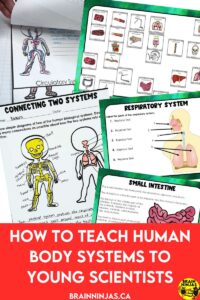
Everyone needs to understand the basic systems that help keep humans alive. The Alberta science curriculum focuses on four main systems: circulatory (cardiovascular), musculoskeletal (bones and muscles), respiratory and digestive. There are many more systems, but this post will focus on teaching these four to your Grade 5 students. Come learn how we teach this unit from beginning to end.
Introduce the Human Body Systems
Before detailing the specific body systems, it’s important to provide students with basic information about these different systems, the human body’s organization and the importance of these systems.
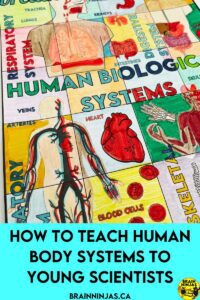
Sometimes students get the giggles, but they must understand that these parts are just body parts. There is nothing to be embarrassed about because all humans have them. The human body systems are important to help all of us survive. We joke that there is no difference between an elbow and a colon because you can’t have either on the table during dinner.
The best way to deal with students who giggle is to have them practice saying it and try to describe body parts just like any other scientific diagram.
If you have students asking about the reproductive systems, you may want to explain that those systems are not part of this science lesson. From there you can decide if and when those systems are taught (usually as part of your health lessons instead).
Organization of the Human Body
Explain to students that the human body is made up of many different systems, each with its own set of organs and functions. These systems work together to help keep humans healthy.
Role of Body Systems
Introduce students to the musculoskeletal, circulatory, respiratory, and digestive systems and explain their primary functions in the body. Emphasize how these systems work together to support life processes. The musculoskeletal system is the bones and muscles. The circulatory is also called the cardiovascular system. This is everything related to the heart and blood (as well as other cells that need to be moved throughout the body). The respiratory system focuses on the lungs and breathing. Lastly, the digestive system is all about processing nutrients and disposing of waste.
Introducing the Body Systems Through a Simple Art Project
We also have a collaborative poster that highlights the four systems in a visual way. Our collaborative posters include 18, 24 or 36 pieces making them easy to use with any size class. Each student colours a piece and then they are assembled into a poster. We’ve also included all the instructions to run the activity and a follow-up activity for your early finishers or take the activity a step further. Find our Human Body Systems Collaborative Poster on TpT ($USD) or our BN Shop ($CAN).
Exploring Each Body System Further
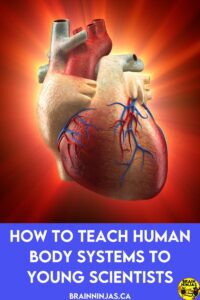
We wrote lessons to teach each of the systems in detail. Our lessons come with complete lesson plans, student pages, answer keys and background information for teachers. They also include a digital version which can be used to differentiate for students or reduce your printing. Find Human Body Systems on TpT ($USD) or our BN Shop ($CAN).
The activities listed in this post differ from those included in our lessons, but cover the same concepts.
Musculoskeletal System
Explain to students that the musculoskeletal system consists of muscles, bones, and joints that work together to support the body and enable movement.
We typically look at the bones in the skeleton, but stick to the major ones. Students learn about the skull, rib cage, spine, femur first. From there we introduce bones in the arms, legs, hands and feet but don’t expect students to memorize these. We teach the different types of muscles: skeletal, cardiac, and smooth muscle. Next, we talk about where these different muscles are found and what they do (in very broad terms).
Circulatory System
Describe to students that the circulatory system, composed of the heart, blood vessels, and blood, transports nutrients, oxygen, and waste products throughout the body. We touch on the different types of cells and vessels like arteries, veins and capillaries. Plasma and other hormones are also discussed, but not memorized. We compare the circulatory system to a system of highways used to transport materials needed throughout the body.
Respiratory System
Educate students on how the respiratory system, including the lungs and airways, facilitates breathing and gas exchange, allowing the body to obtain oxygen and remove carbon dioxide. We teach students how oxygen is converted to carbon dioxide and where these gases go once they’re exchanged. Students learn how to take care of their lungs.
Digestive System
Introduce students to the digestive system, comprising the digestive tract and associated organs, which break down food into nutrients for the absorption and the elimination of waste. This system starts at the mouth and ends at the rectum. The digestive system causes the most giggles, but it’s actually one of the most fascinating and complex systems.
Hands-on Activities to Teach Human Body Systems
Activities for the Musculoskeletal System
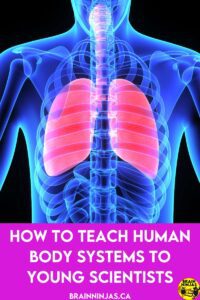
Engage students in hands-on activities such as stretching exercises or muscle demonstrations using resistance bands. Show students that skeletal muscles are responsible for moving the bones, but they only work in one direction. Gravity does the rest.
Clean, dry and back chicken bones and use them to explore skeletal models.
Create a model using craft supplies of the skeleton or different muscles.
Activities for the Circulatory System
Conduct simple experiments to simulate blood flow using water and tubing.
Create heart models using clay or playdough.
Listen to heart sounds using stethoscopes.
Compare how a pump works to how the heart pumps.
Activities for the Respiratory System
Do breathing exercises while placing a hand against the diaphragm to feel the muscles moving. Try breathing slowly through a straw to feel how deep the air goes (it will feel like it’s going into the stomach) compared to breathing quickly through the nose (shallow breathing). Can students breathe through their noses when their mouth is open?
Observe lung anatomy using preserved specimens or virtual simulations. This was a lot harder to do since we’re an elementary classroom and don’t have a science lab.
Demonstrate lung capacity using balloons. Students can try to fill a balloon with one breath. We found this great activity which is much simpler for elementary students.
Activities for the Digestive System
Conduct digestion experiments using food items such as crackers and bananas. Place the food in a small bag and squish it to simulate chewing. Add a little water to simulate saliva. Continue squishing to simulate the muscles in the digestive system.
Other Resources About Human Body Systems
Books
The Magic School Bus Inside the Human Body by Joanna Cole
Human Body: A Visual Encyclopedia by DK
The Circulatory System by Joseph Midthun
Go With the Flow: The Circulatory System by Racquel Thompson
The Science of the Heart and Circulatory System by Louise A Spilsbury and Richard Spilsbury
Skully the Peg Legged Skeleton: Learns About Bones by Brittaney Tompkins
The Muscle System The Amazing Human Body and Its Systems Grade 4 Children’s Anatomy Books by Baby Professor
Muscles: Our Muscular System by Seymour Simon
Investigating the Respiratory System by Natalie Hyde
Respiratory System (A True Book: Your Amazing Body) by Cody Crane
Your Respiratory System Works! by Flora Brett
How Food Travels In The Body – Digestive System
Investigating the Digestive System by Baby Professor by Natalie Hyde
Videos
CrashCourses https://www.youtube.com/playlist?list=PL8dPuuaLjXtOAKed_MxxWBNaPno5h3Zs8
NatGeoKids (digestive system) https://www.natgeokids.com/uk/discover/science/general-science/your-digestive-system/
Operation Ouch https://www.youtube.com/watch?v=AX34MoaLmzE
Websites
KidsHealth.org https://kidshealth.org/en/kids/center/htbw-main-page.html
InnerBody.com https://www.innerbody.com/htm/body.html
Reviewing the Unit
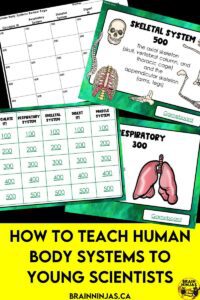
Once you’ve taught the lessons, this interactive game is a fun way to see what students have learned or review before a unit test. Each of the twenty-five questions can be checked by students so it’s a great game for students to play on their own or in small groups. Find Human Body Systems Interactive Game on TpT ($USD) or our BN Shop ($CAN).
All of the body systems lessons are included in a money-saving bundle. Find our Human Body Systems Unit on TpT ($USD) or our BN Shop ($CAN). If you teach in Alberta, the Human Body Systems is part of the Living Systems Unit for Grade 5 and is available on TpT ($USD) or our BN Shop ($CAN).
Teaching students about the musculoskeletal, circulatory, respiratory, and digestive systems offers a quick peek into the fascinating body systems. Through inquiry, students can develop a deeper understanding of their bodies.
Do You Teach Science?
If you teach in Alberta, we’ve got resources just for you. We have been writing resources for the new science curriculum. You can see our progress on this page. If you teach science in Canada, these blog posts will be helpful:
- How to Shock Your Students With Engaging Electricity Lessons
- How to Leverage Critical Thinking Challenges to Your Advantage
- 10 Engaging Weather Lessons All in One Place
- How to Grow a Healthy Classroom with Plants
- How to Learn About Wetlands Without A Pond
- 15 Simple Machines Activities that Will Hook Your Students
- How to Escalate Your Chemistry Experiments
- Astronomy Lessons That Are Out of This World
- Create These 5 Fantastic Devices That Move
- Foster Environmental Stewardship in the Classroom
- How to Teach Students About the Earth’s Spheres
How do you teach human body systems? We’d love to hear about it. Leave us a comment below.






